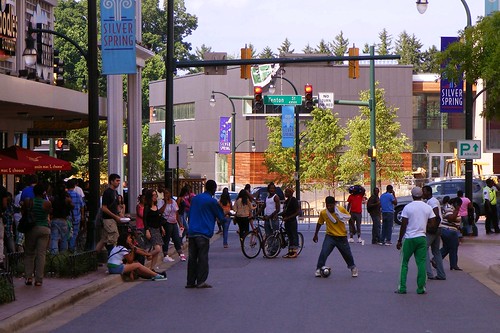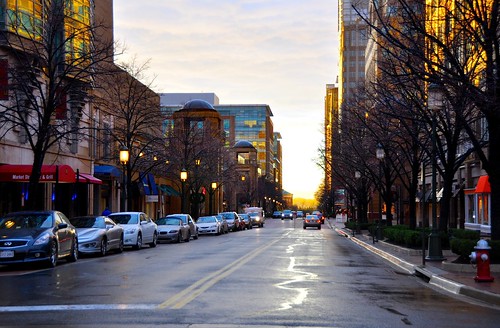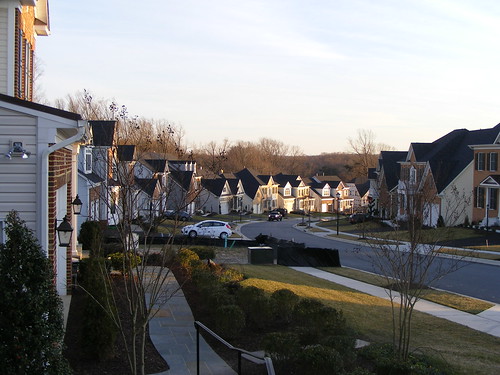 |
| Downtown Silver Spring, a symbol of white flight? |
Doig cites a recent report from George Washington University professor Christopher Leinberger on the growth of "walkable urban places," or "WalkUPs," in the DC area. The study identifies 43 WalkUPs in the region, more than half of which aren't in the District. To Doig, this is bad news:
Fact: People want to live in walkable urban places. Problem: Walkable urban places sometimes have attributes (bad schools, high costs, crime) that people don't like. Solution: Build new walkable urban places out in the suburbs. Result: A whole new type of place that offers the city experience without the actual city.Doig falls prey to the same mistake a lot of writers make on urban issues. For starters, he presents "city" and "suburb" as mutually exclusive entities with no middle ground. A place can either be like Doig's former neighborhood, Columbia Heights in the District, or Reston Town Center in Northern Virginia. One represents "urban authenticity" where "scrappy entrepreneuralism and creativity" can occur, the other's a "jury-rigged" "urban simulacra" that's just a "marketing tool."
 |
 |
| Columbia Heights: "Urban authenticity"? Photo by the author. | Reston Town Center: "Urban simulacra"? Photo by jsprague2020 on Flickr. |
Just look at Eastern Avenue, which forms part of the border between the District and Montgomery County. On the District side are single-family homes with leafy yards, while across the street in Maryland in "suburban" Silver Spring are high-rise apartment towers. Take a few more steps into Maryland and you'll find the punk houses, dive bars and ethnic restaurants that Doig would call emblems of urban grit and authenticity.
Doig's other mistake is to conflate "suburb" with "wealthy and white." Greater Washington may be home to 7 of the nation's wealthiest counties, but we're also one of the country's most diverse regions. Our suburban downtowns don't represent white flight; in fact, whites are moving into the city.
 |
| The Quarry House Tavern (shown in 2006), a dive bar below an Indian restaurant in "contrived" downtown Silver Spring. Photo by katmere on Flickr. |
It's these changes, not white flight, that will drive the creation of more suburban downtowns in the future. A study from University of Maryland professor Dr. Shenglin Chang found that many Asian and Latino immigrants are drawn to these places, which combine the idyllic suburban lifestyle America is known for around the world with the conveniences and community life they were accustomed to at home.
That said, suburban downtowns aren't perfect. Doig rightly points out that many have serious issues with urban design, can be difficult to reach without a car, and often cater to the affluent. These issues can and should be corrected.
However, writing these places off as "inauthentic" is not only unfair but lazy. As Scott Doyon on the Placemakers blog notes, this suggests that the only "authentic" suburban places are the strip malls and cul-de-sacs that fit our mental stereotypes. Not only is that a disservice to the people who might actually enjoy places like Reston Town Center, but it ignores power these places have to make better communities.
 |
| An "authentic" suburban street, lined with two-car garages and trim lawns. Photo by the author. |
These places won't be new and pristine forever. With time, they'll mature and evolve. In the 1930's, a developer in Princeton, New Jersey basically built a downtown from scratch in the 1930's, but today it's a beloved part of the city.
As Dan Malouff (who was quoted extensively in the article) points out, the demand for "walkable urban" places far outstrips the supply of existing walkable urban places, necessitating the creation of more of them. The DC area and America as a whole continues to grow, and many of them will choose to live in the suburbs for a variety of reasons. Our country may be undergoing an "urban renaissance," but much of it will happen beyond the city line.
The "city versus suburbs" slant is tired and inaccurate. It's time we got rid of it and instead focused on whether we're creating good places, no matter what side of Eastern Avenue or the Potomac River they're on.

5 comments:
Very well said.
Personally, i think Silver Spring is a great example of suburban neighborhoods having the capacity to be just as, if not more, urban than city proper neighborhoods. sure SS can't compete w/Dupont's street grid or Georgetown's history, but as far as being a dense, socio-economic and culturally diverse, walkable community that has efficiently integrated office, retail, and residential needs? I find Silver Spring is much more urban than the vast majority of DC and any city-proper neighborhood I've had the pleasure of living in over the years.
Cleveland Park or Downtown Silver Spring. Which is more "wealthy and white"?
Great defense of Silver Spring and other DC Metro walk ups! I completely agree.
I do think that some new walk up communities probably won't qualify as urban. I'm unsure about Kings Farm, or the proposed life sciences park up 270, or perhaps National Harbor. I appreciate the walkable characteristics of all of these, but given their disconnection from high capacity transit, I think they're effectively new towns rather than part of a polycentric city.
Now of course, cities pre-date modern public transportation. So any number of locations can qualify as urban based solely on their inherent density and proximity to other density.
Regardless, I wouldn't necessarily call such town centers in-authentic. However, I do think that they will likely be taxing on infrastructure in a way that say plopping down a brand new development at an existing Metro park and ride commuter stop would not be.
you are always going to see this mix of urban and suburban in places where you have a small central city with defined borders. D. C. is similar to St. Louis in that regard. If D. C. had annexation powers you might have seen Silver Spring annexed to D. C. 30 to 40 years ago. After a while it gets tiresome to argue over the labels.
Agree -- I moved to SS from Dupont and while SS is not quite as dense, it is far more diverse by income, race, and country of origin.
Post a Comment